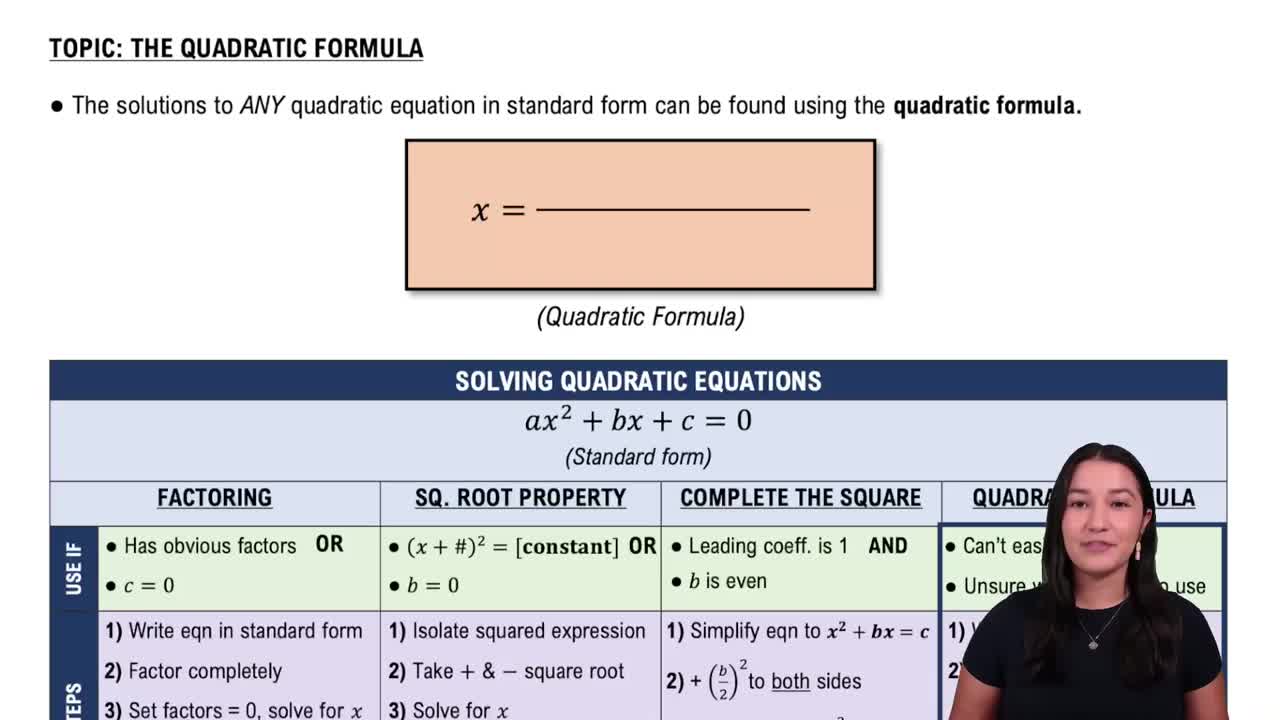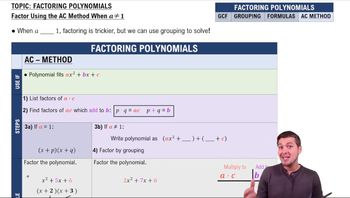Table of contents
- 0. Review of Algebra4h 16m
- 1. Equations & Inequalities3h 18m
- 2. Graphs of Equations43m
- 3. Functions2h 17m
- 4. Polynomial Functions1h 44m
- 5. Rational Functions1h 23m
- 6. Exponential & Logarithmic Functions2h 28m
- 7. Systems of Equations & Matrices4h 6m
- 8. Conic Sections2h 23m
- 9. Sequences, Series, & Induction1h 19m
- 10. Combinatorics & Probability1h 45m
0. Review of Algebra
Factoring Polynomials
Problem 40a
Textbook Question
Factor each trinomial, if possible. See Examples 3 and 4. 9x^2+4x-2
 Verified step by step guidance
Verified step by step guidance1
Identify the trinomial in the form \( ax^2 + bx + c \), where \( a = 9 \), \( b = 4 \), and \( c = -2 \).
Multiply \( a \) and \( c \) to get \( 9 \times (-2) = -18 \).
Find two numbers that multiply to \(-18\) and add to \(4\). These numbers will be used to split the middle term.
Rewrite the trinomial by splitting the middle term \(4x\) using the two numbers found in the previous step.
Factor by grouping: Group the terms into two pairs and factor out the greatest common factor from each pair, then factor out the common binomial factor.
Recommended similar problem, with video answer:
 Verified Solution
Verified SolutionThis video solution was recommended by our tutors as helpful for the problem above
Video duration:
5mPlay a video:
Was this helpful?
Key Concepts
Here are the essential concepts you must grasp in order to answer the question correctly.
Factoring Trinomials
Factoring trinomials involves rewriting a quadratic expression in the form ax^2 + bx + c as a product of two binomials. This process requires identifying two numbers that multiply to ac (the product of a and c) and add to b. Understanding this concept is essential for simplifying expressions and solving quadratic equations.
Recommended video:
Guided course

Factor Using Special Product Formulas
Quadratic Formula
The quadratic formula, x = (-b ± √(b² - 4ac)) / (2a), provides a method for finding the roots of a quadratic equation. It is particularly useful when factoring is difficult or impossible. Knowing how to apply this formula can help verify the factors of a trinomial and find its solutions.
Recommended video:

Solving Quadratic Equations Using The Quadratic Formula
Discriminant
The discriminant, given by the expression b² - 4ac, determines the nature of the roots of a quadratic equation. If the discriminant is positive, there are two distinct real roots; if it is zero, there is one real root; and if negative, there are no real roots. Understanding the discriminant helps in predicting whether a trinomial can be factored over the real numbers.
Recommended video:

The Discriminant

 7:30m
7:30mWatch next
Master Introduction to Factoring Polynomials with a bite sized video explanation from Patrick Ford
Start learningRelated Videos
Related Practice










